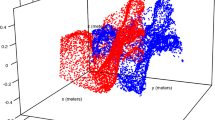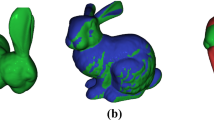Abstract
Point clouds are one of the most primitive and fundamental manifold representations. A popular source of point clouds are three-dimensional shape acquisition devices such as laser range scanners. Another important field where point clouds are found is the representation of high-dimensional manifolds by samples. With the increasing popularity and very broad applications of this source of data, it is natural and important to work directly with this representation, without having to go through the intermediate and sometimes impossible and distorting steps of surface reconstruction. Under the assumption that the underlying object is a submanifold of Euclidean space, we first discuss how to approximately compute geodesic distances by using only the point cloud by which the object is represented. We give probabilistic error bounds under a random model for the sampling process. Later in the chapter we present a geometric framework for comparing manifolds given by point clouds. The underlying theory is based on Gromov—Hausdorff distances, leading to isometry invariant and completely geometric comparisons. This theory is embedded in a probabilistic setting, as derived from random sampling of manifolds, and then combined with results on matrices of pairwise geodesic distances to lead to a computational implementation of the framework.
Access this chapter
Tax calculation will be finalised at checkout
Purchases are for personal use only
Preview
Unable to display preview. Download preview PDF.
Similar content being viewed by others
References
N. Amenta, S. Choi, and R. K. Kolluri. The power crust, unions of balls, and the medial axis transform. Comput. Geom., 19(2–3):127–153, 2001.
D. Burago, Y. Burago, and S. Ivanov. A Course in Metric Geometry, volume 33 of AMS Graduate Studies in Math. American Mathematical Society, 2001.
J.-D. Boissonnat and F. Cazals. Coarse-to-fine surface simplification with geometric guarantees. In Proc. Eurographics Symp. on Comput. Geom., 2001.
M. Bernstein, V. de Silva, J. Langford, and J. Tenenbaum. Graph approximations to geodesics on embedded manifolds. Technical report, 2000.
J. Borwein and O. Hijab. http://www.siam.org/journals/problems/ downloadfiles/99-5sii.pdf
D. Burago and B. Kleiner. Separated nets in Euclidean space and Jacobians of bi-Lipschitz maps. Geom. Funct. Anal., 8:273–282, 1998.
D. Burago and B. Kleiner. Rectifying separated nets. Geom. Funct. Anal., 12:80–92, 2002.
M. Boutin and G. Kemper. On reconstructing n-point configurations from the distribution of distances or areas. Adv. in Appl. Math., 32(4):709–735, 2004.
M. Botsch, A. Wiratanaya, and L. Kobbelt. Efficient high quality rendering of point sampled geometry. In Proceedings of the 13th Eurographics Workshop on Rendering, pages 53–64. Eurographics Association, 2002.
G. Charpiat, O. Faugeras, and R. Keriven. Shape metrics, warping, and statistics. In Proceedings of the International Conference on Image Processing, 2003.
J. Costa and A. O. Hero. Geodesic entropic graphs for dimension and entropy estimation in manifold learning. IEEE Trans. on Signal Processing, 52:2210–2221, August 2004.
I. Chavel. Riemannian Geometry: A Modern Introduction. Cambridge University Press, Cambridge, UK, 1997.
R. Coifman. Personal communication.
A. Collins, A. Zomorodian, G. Carlsson, and L. Guibas. A barcode shape descriptor for curve point cloud data. In Proc. Symposium on Point-Based Graphics, ETH, Zürich, Switzerland, 2004.
M. P. do Carmo. Riemannian geometry. Mathematics: Theory and Applications. Birkhäuser Boston Inc., Boston, MA, 1992.
N. Dyn, M. S. Floater, and A. Iske. Adaptive thinning for bivariate scattered data. J. Comput. Appl. Math., 145(2):505–517, 2002.
T. K. Dey, J. Giesen, and J. Hudson. Decimating samples for mesh simplification. In Proc. 13th Canadian Conference on Computational Geometry, pages 85–88, 2001.
A. Dvoretzky. On covering a circle by randomly placed arcs. Proc. Nat. Acad. Sci. U.S.A., 42:199–203, 1956.
A. Elad (Elbaz) and R. Kimmel. Bending invariant representations for surfaces. Proc. of CVPR’01 Hawaii, 2001.
W. Feller. An Introduction to Probability Theory and its Applications. John Wiley & Sons, Inc., New York-London-Sydney, 1971.
L. Flatto. A limit theorem for random coverings of a circle. Israel J. Math., 15:167–184, 1973.
L. Flatto and D. J. Newman. Random coverings. Acta Math., 138(3–4):241–264, 1977.
P. Frosini. A distance for similarity classes of submanifolds of Euclidean space. Bull. Austral. Math. Soc., 42:3:407–416, 1990.
M.T. Goodrich, J. S. B. Mitchell, and M. W. Orletsky. Approximate geometric pattern matching under rigid motions. IEEE Transactions on Pattern Analysis and Machine Intelligence, 21(4):371–376, 1999.
[GPZ+]_M. Gross, H. Pfister, M. Zwicker, M. Pauly, M. Stamminger, and M. Alexa. Point based computer graphics. EUROGRAPHICS 2002 Lecture Notes.
A. Gray. Tubes. Addison-Wesley Publishing Company Advanced Book Program, Redwood City, CA, 1990.
K. Grove. Metric differential geometry. In Differential geometry, volume 1263 of Lecture Notes in Math., pages 171–227. Springer, Berlin, 1987.
M. Gromov. Asymptotic invariants of infinite groups. In A. Niblo and Martin A. Roller, editors, Geometric group theory, volume 2 of London Math. Soc. Lecture Notes Ser., pages 1–295. Cambridge Univ. Press, Cambridge, UK, 1993.
M. Gromov. Metric structures for Riemannian and non-Riemannian spaces, volume 152 of Progress in Mathematics. Birkhäuser, Boston, 1999.
J. Giesen and U. Wagner. Shape dimension and intrinsic metric from samples of manifolds with high co-dimension. In Proceedings of the Nineteenth Annual Symposium on Computational Geometry, pages 329–337. ACM Press, New York, 2003.
P. Hall. Introduction to the theory of coverage processes. Wiley Series in Probability and Mathematical Statistics. John Wiley & Sons Inc., New York, 1988.
J. Hoffmann-Jørgensen. Coverings of metric spaces with randomly placed balls. Math. Scand., 32:169–186, 1973.
A. Ben Hamza and Hamid Krim. Geodesic object representation and recognition. In Lecture Notes in Computer Science, volume 2886, pages 378–387, 2003.
D. P. Huttenlocher, G. A. Klanderman, and W. J. Rucklidge. Comparing images using the Hausdorff distance. IEEE Transactions on Pattern Analysis and Machine Intelligence, 15:9, 1993.
J. Helmsen, E. G. Puckett, P. Collela, and M. Dorr. Two new methods for simulating photolithography development in 3d. In Proc. SPIE Microlithography IX, pages 253–261, 1996.
S. Janson. Random coverings in several dimensions. Acta Math., 156(1–2):83–118, 1986.
D. W. Kahn. Topology. An Introduction to the Point-Set and Algebraic Areas. Williams & Wilkins Co., Baltimore, MD, 1975.
M. G. Kendall and P. A. P. Moran. Geometrical probability. Griffin’s Statistical Monographs & Courses, No. 10. Hafner Publishing Co., New York, 1963.
N. J. Kalton and M. I. Ostrovskii. Distances between Banach spaces. Forum Math., 11:1:17–48, 1999.
R. Kimmel and J. A. Sethian. Computing geodesic paths on manifolds. Proc. Natl. Acad. Sci. USA, 95(15):8431–8435 (electronic), 1998.
R. Kunze, F. Wolter, and T. Rausch. Geodesic Voronoi diagrams on parametric surfaces. In Proceedings of the 1997 Conference on Computer Graphics International, page 230. IEEE Computer Society, 1997.
S. Lafon. Diffusion maps and geometric harmonics. Ph.D. thesis, Yale University, New Haven, CT, May 2004.
G. Leibon and D. Letscher. Delaunay triangulations and Voronoi diagrams for Riemannian manifolds. In Proceedings of the Sixteenth Annual Symposium on Computational Geometry, pages 341–349. ACM Press, New York, 2000.
L. Linsen and H. Prautzsch. Local versus global triangulations. In Proc. Eurographics’ 01, 2001.
C. T. McMullen. Lipschitz maps and nets in Euclidean space. Geom. Funct. Anal., 8:304–314, 1998.
C. Moenning and N. A. Dodgson. Fast marching farthest point sampling for implicit surfaces and point clouds. Technical Report 565, Cambridge University Computer Laboratory, Cambridge, UK, 2003.
C. Mantegazza and A. C. Mennucci. Hamilton-Jacobi equations and distance functions on Riemannian manifolds. Appl. Math. Optim., 47(1):1–25, 2003.
[MMS+04]_C. Moenning, F. Mémoli, G. Sapiro, N. Dyn, and N. A. Dodgson. Meshless geometric subdivision. Technical Report 1977, Institute for Mathematics and its Applications, University of Minnesota, Minneapolis, USA, 2004. http://www.ima.umn.edu/preprints/apr2004/1977.pdf
N. J. Mitra and A. Nguyen. Estimating surface normals in noisy point cloud data. In Proc. 19th Conf. on Comput. Geom., pages 322–328, 2003.
F. Mémoli and G. Sapiro. Fast computation of weighted distance functions and geodesics on implicit hyper-surfaces. J. Comput. Phys., 173(2):730–764, 2001.
F. Mémoli and G. Sapiro. A theoretical and computational framework for isometry invariant recognition of point cloud data. Technical Report 1980, University of Minnesota, IMA, 2004. http://www.ima.umn.edu/preprints/jun2004/1980.pdf, to appear J. Foundations Computational Mathematics.
F. Mémoli and G. Sapiro. Distance functions and geodesics on submanifolds of ℝd and point clouds. SIAM J. Appl. Math., 65(4):1227–1260, 2005.
V. V. Nekrashevych. On equivalence of nets in hyperbolic spaces. Dopov. Nats. Akad. Nauk Ukr. Mat. Prirodozn. Tekh. Nauki, pages 18–21, 1997.
P. Niyogi, S. Weinberger, and S. Smale. Finding the homology of submanifolds with high confidence from random samples. Technical Report TR-2004-08, Department of Computer Science, University of Chicago, November 2004.
P. Petersen. Gromov-Hausdorff convergence of metric spaces. In Differential geometry: Riemannian geometry, Proc. Sympos. Pure Math., volume 54 Part 3, pages 489–504. Amer. Math. Soc., Providence, RI, 1993.
P. Petersen. Riemannian Geometry. Springer-Verlag, New York,, 1998.
M. Pauly and M. Gross. Spectral processing of points sampled geometry. In ACM SIGGRAPH, pages 379–386, 2001.
M. Pauly, M. Gross, and L. P. Kobbelt. Efficient simplification of pointsampled surfaces. In Proc. 13th IEEE Visualization, pages 163–170, 2002.
S. Rusinkiewicz and M. Levoy. Qsplat: a multiresolution point rendering system for large meshes. In Proc. SIGGRAPH’ 00, pages 343–352, 2000.
T. Sakai. Riemannian geometry, volume 149 of Translations of Mathematical Monographs. American Mathematical Society, Providence, RI, 1996.
H. Von Schelling. Coupon collecting for unequal probabilities. Amer. Math. Monthly, 61:306–311, 1954.
J. Sethian. Fast marching level set methods for three-dimensional photolithography development. In Proc. SPIE International Symposium on Microlithography, 1996.
J. A. Sethian. A fast marching level set method for monotonically advancing fronts. Proc. Nat. Acad. Sci. U.S.A., 93(4):1591–1595, 1996.
C. E. Shannon. Coding theorems for a discrete source with a fidelity criterion. In Information and Decision Processes, pages 93–126. McGraw-Hill, New York, 1960.
L. A. Shepp. Covering the circle with random arcs. Israel J. Math., 11:328–345, 1972.
H. Solomon. Geometric Probability. Society for Industrial and Applied Mathematics, Philadelphia, PA., 1978.
E. Schwartz, A. Shaw, and E. Wolfson. A numerical solution to the generalized mapmaker’s problem: Flattening nonconvex polyhedral surfaces. IEEE Transactions on Pattern Analysis and Machine Intelligence, 11(9):1005–1008, 1989.
R. Tsai, L. T. Cheng, S. Osher, and H.-K. Zhao. Fast sweeping algorithms for a class of Hamilton-Jacobi equations. SIAM J. Numer. Anal., 41(2):673–694 (electronic), 2003.
J. B. Tenenbaum, V. deSilva, and J. C. Langford. A global geometric framework for nonlinear dimensionality reduction. Science, pages 2319–2323, 2000.
D. Toledo. Book review: Geometric group theory vol 2: Asymptotic invariants of infinite groups. Bull. Amer. Math. Soc., 33:395–398, 1996.
J. N. Tsitsiklis. Efficient algorithms for globally optimal trajectories. IEEE Transactions on Automatic Control, (40):1528–1538, 1995.
M. Zwicker, M. Pauly, M. Knoll, and M. Gross. Pointshop3d: An interactive system for point-based surface editing. Proc. SIGGRAPH’ 02, pages 322–329, 2002.
Author information
Authors and Affiliations
Editor information
Editors and Affiliations
Copyright information
© 2006 Birkhäuser Boston
About this chapter
Cite this chapter
Mémoli, F., Sapiro, G. (2006). Computing with Point Cloud Data. In: Krim, H., Yezzi, A. (eds) Statistics and Analysis of Shapes. Modeling and Simulation in Science, Engineering and Technology. Birkhäuser Boston. https://doi.org/10.1007/0-8176-4481-4_8
Download citation
DOI: https://doi.org/10.1007/0-8176-4481-4_8
Publisher Name: Birkhäuser Boston
Print ISBN: 978-0-8176-4376-8
Online ISBN: 978-0-8176-4481-9
eBook Packages: Mathematics and StatisticsMathematics and Statistics (R0)




